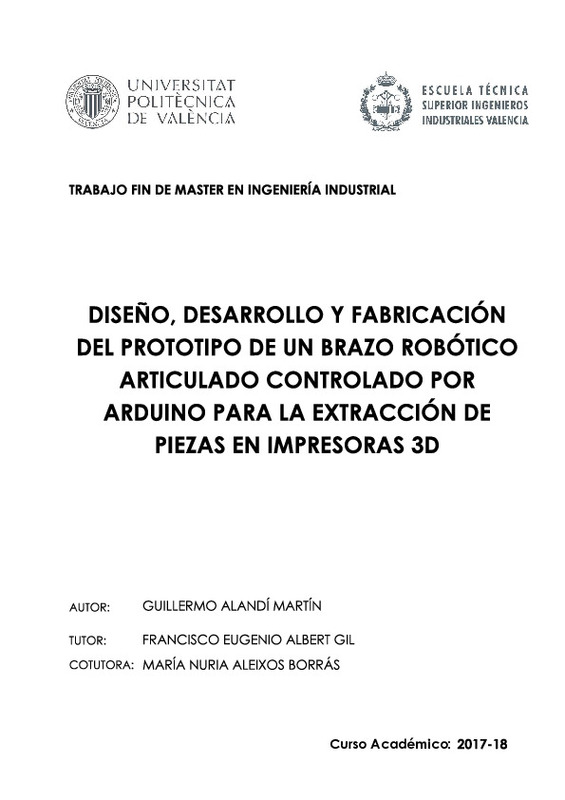|
Resumen:
|
[ES] Actualmente se está desarrollando una nueva industria en torno al prototipado rápido o impresión 3D que posibilita a los consumidores tener acceso a un bajo coste. Es posible diseñar un producto utilizando software ...[+]
[ES] Actualmente se está desarrollando una nueva industria en torno al prototipado rápido o impresión 3D que posibilita a los consumidores tener acceso a un bajo coste. Es posible diseñar un producto utilizando software CAD y realizar un prototipo real del mismo enviándolo a imprimir, como si de un archivo de texto se tratase.
A lo largo del documento se muestra el desarrollo de producto de un brazo robótico destinado a la extracción de piezas en impresoras 3D, abordando la fase de fabricación y de ensamblaje como parte del diseño.
En primer lugar, se especifican las características geométricas del prototipo y los elementos clave que sentarán las bases del diseño. A continuación, se realiza un análisis del movimiento utilizando un mecanismo de barras simple, dando como resultado el par de torsión necesario para mover el brazo robótico y en consecuencia el tamaño de los servomotores, necesario para modelar el conjunto de piezas.
En la fase de modelado de las piezas se muestran las líneas de diseño, pensando en todo momento en la fabricación (dividiendo piezas en dos componentes para optimizar el proceso de impresión) y el montaje, sin renunciar al componente estético que se persigue. A continuación, se ensamblan todas las piezas en un modelo digital del brazo robótico, lo que posibilita realizar ajustes de posicionamiento de los elementos o correcciones geométricas antes de proseguir a la siguiente fase.
Tras esto, cada pieza se fabrica utilizando una impresora 3D doméstica con el fin de realizar el montaje de todas las partes y crear un prototipo funcional.
Por último, se realiza el cableado de todos los sistemas eléctricos y se escribe el código de control del brazo robótico, que debe ser capaz de ponerse en funcionamiento una vez terminada la impresión de la pieza a extraer con la siguiente secuencia: aproximarse a la pieza, cogerla y depositarla fuera del perímetro de impresión.
[-]
[EN] A new industry is currently being developed around rapid prototyping or 3D printing that enables
consumers to access it at a low cost. It is possible to design a product using CAD software and make a
real prototype ...[+]
[EN] A new industry is currently being developed around rapid prototyping or 3D printing that enables
consumers to access it at a low cost. It is possible to design a product using CAD software and make a
real prototype of it by sending it to print, as if it were a text file.
Throughout the document the product development of a robotic arm for the extraction of parts in 3D
printers is taught, addressing the manufacturing and assembly phase as part of the design.
First, the geometric characteristics of the prototype and the key elements that will form the basis of
the design are specified. A motion analysis is then performed using a simple bar mechanism, resulting
in the torque required to move the robotic arm and hence the size of the servomotors required to
model the set of parts.
In the modeling phase, the design lines are shown, thinking at all times of the manufacturing (dividing
pieces into two components to optimize the printing process) and the assembly, without renouncing
the aesthetic component that is being pursued. All the parts are then assembled into a digital model
of the robotic arm, which makes it possible to make adjustments to the positioning of the elements or
geometric corrections before proceeding to the next phase.
After this, each part is manufactured using a 3D home printer in order to assemble all the parts and
create a functional prototype.
Finally, all the electrical systems are wired and the control code of the robotic arm is written, which
must be able to be put into operation once the printing of the part to be extracted has been completed
with the following sequence: approach the part, take it and place it outside the printing perimeter.
[-]
|







